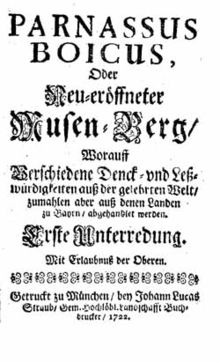Parnassus boicus
Parnassus Boicus (Bavarian Mountain Muse) был баварским обществом, основанным в 1722 году, и название журнала, опубликованного Обществом.
Происхождение
[ редактировать ]Общество было основано на плане, начатом 1720 года тремя августинскими отцами. Евсевий Аморт (1692–1775) был ведущим богословом и противником иезуитов. Геласия Хибер (1671–1731) был известным проповедником на немецком языке . Агнелл Кандлер (1692–1745) был генеалогом и библиотекарем. Первоначальные планы провалились, но в 1722 году они выпустили первое издание Parnassus Boicus , сообщая интересную информацию из искусств и наук. [ 1 ]
Журнал
[ редактировать ]Научный периодический Parnassus Boicus начал публикацию в Мюнхене в 1722 году. [ 2 ] Parnassus Boicus или Neu-Open Musen-Berg продолжали публиковать до 1740 года. [ 3 ] Между 1722 и 1727 годами появились двадцать четыре вопроса журнала, опубликованные спорадически. В первом вопросе были проблемы с баварской топографией, правителями и древними законами. Последующие проблемы имели гораздо более широкий охват. [ 1 ]
In a three-part article that appeared in 1723–24 the journal defended the German language for its periodic and heroic (Heldensprache) qualities.[ 3 ] The journal pioneered scientific methods in Germany, with an emphasis on experimental verification. For example, in 1725 the journal published an article attacking alchemy, claiming to give fundamental proof that it was impossible to make gold. Although alchemy remained widely accepted for some time, the investigations proposed by the Parnassus Boicus would destroy the hermetic concepts that it rested on.[2]
Franz Josef Grienwaldt (1708–1743) was a student of Johann Adam Morasch (1682–1734) and Johann Jakob Treiling (1681–1758), professors of medicine at the University of Ingolstadt. Grienwaldt moved to the Protestant University of Altdorf, and received his doctorate in 1732. On the recommendation of Andreas Elias Büchner he was accepted as a member of the Leopoldina Academy. From 1736 to 1740 he was editor of the Parnassus boicus.[4]
Influence
[edit]Although the society closed in 1740, it had lasting impact. On 12 October 1758 the lawyer Johann Georg Lori (1723–1787), Privy Counsellor at the College of Coinage and Mining in Munich, founded the Bayerische Gelehrte Gesellschaft (Learned Society of Bavaria). This led to the foundation on 28 March 1769 of the Bavarian Academy of Sciences and Humanities, with Count Sigmund von und zu Haimhausen as the first president. The academy's foundation charter specifically mentions the Parnassus Boicus.[5]
References
[edit]Citations
- ^ Jump up to: a b Blackall 1954, p. 98.
- ^ Jump up to: a b Yearsley 2002, p. 90.
- ^ Jump up to: a b Scaglione 1981, p. 28.
- ^ Mücke 2013, p. 184.
- ^ Geschichte: Bayerische Akademie der Wissenschaften.
Sources
- Blackall, Eric A. (January 1954). "The Parnassus Boicus and the German Language". German Life and Letters. 7 (2): 98–108. doi:10.1111/j.1468-0483.1954.tb01121.x.
- "Geschichte". Bayerische Akademie der Wissenschaften. Retrieved 2013-12-17.
- Mücke, Marion (2013-05-03). "Between Status, Attainment and Professional Dialogue". Scholars in Action (2 vols): The Practice of Knowledge and the Figure of the Savant in the 18th Century. BRILL. ISBN 978-90-04-24391-0. Retrieved 2013-12-17.
- Scaglione, Aldo D. (1981). The Theory of German Word Order from the Renaissance to the Present. U of Minnesota Press. ISBN 978-0-8166-0983-3. Retrieved 2013-12-17.
- Yearsley, David (2002-11-14). Bach and the Meanings of Counterpoint. Cambridge University Press. ISBN 978-0-521-80346-5. Retrieved 2013-12-17.
